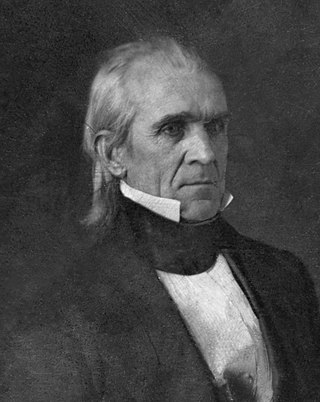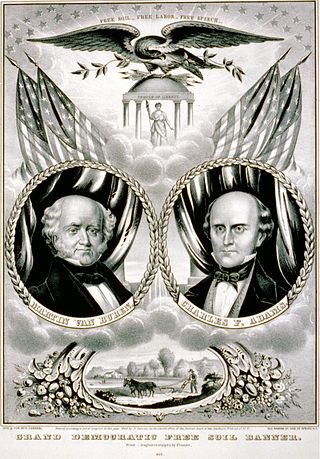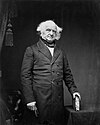
Martin Van Buren was an American lawyer, diplomat, and statesman who served as the eighth president of the United States from 1837 to 1841. A primary founder of the Democratic Party, he served as New York's attorney general and U.S. senator, then briefly as the ninth governor of New York before joining Andrew Jackson's administration as the tenth United States secretary of state, minister to Great Britain, and ultimately the eighth vice president when named Jackson's running mate for the 1832 election. Van Buren won the presidency in 1836 against divided Whig opponents, the first president of non-Anglo-Saxon heritage and so far the only speaking English as a second language. Van Buren lost re-election in 1840, and failed to win the Democratic nomination in 1844. Later in his life, Van Buren emerged as an elder statesman and an important anti-slavery leader who led the Free Soil Party ticket in the 1848 presidential election.
The Whig Party was a conservative political party that existed in the United States during the mid-19th century. Alongside the slightly larger Democratic Party, it was one of the two major parties in the United States between the late 1830s and the early 1850s as part of the Second Party System. Four presidents were affiliated with the Whig Party for at least part of their terms. Other prominent members of the Whig Party include Henry Clay, Daniel Webster, Rufus Choate, William Seward, John J. Crittenden, and John Quincy Adams. The Whig base of support was centered among entrepreneurs, professionals, planters, social reformers, devout Protestants, and the emerging urban middle class. It had much less backing from poor farmers and unskilled workers.

The 1832 United States presidential election was the 12th quadrennial presidential election, held from Friday, November 2 to Wednesday, December 5, 1832. Incumbent president Andrew Jackson, candidate of the Democratic Party, defeated Henry Clay, candidate of the National Republican Party.

The 1836 United States presidential election was the 13th quadrennial presidential election, held from Thursday, November 3 to Wednesday, December 7, 1836. In the third consecutive election victory for the Democratic Party, incumbent Vice President Martin Van Buren defeated four candidates fielded by the nascent Whig Party.

The 1840 United States presidential election was the 14th quadrennial presidential election, held from Friday, October 30 to Wednesday, December 2, 1840. Economic recovery from the Panic of 1837 was incomplete, and Whig nominee William Henry Harrison defeated incumbent President Martin Van Buren of the Democratic Party. The election marked the first of two Whig victories in presidential elections, but was the only one where they won a majority of the popular vote. This was the third rematch in American history, which would not occur again until 1892.

The 1844 United States presidential election was the 15th quadrennial presidential election, held from Friday, November 1 to Wednesday, December 4, 1844. Democrat James K. Polk defeated Whig Henry Clay in a close contest turning on the controversial issues of slavery and the annexation of the Republic of Texas. This is the only election in which both major party nominees served as Speaker of the House at one point, and the first in which neither candidate held elective office at the time.

The 1848 United States presidential election was the 16th quadrennial presidential election, held on Tuesday, November 7, 1848. In the aftermath of the Mexican–American War, General Zachary Taylor of the Whig Party defeated Senator Lewis Cass of the Democratic Party.

The 1852 United States presidential election was the 17th quadrennial presidential election, held on Tuesday, November 2, 1852. Democrat Franklin Pierce defeated Whig nominee General Winfield Scott. A third party candidate from the Free Soil party, John P. Hale, also ran and came in third place, but got no electoral votes.

The Free Soil Party was a short-lived coalition political party in the United States active from 1848 to 1854, when it merged into the Republican Party. The party was largely focused on the single issue of opposing the expansion of slavery into the western territories of the United States.

The 1839 Whig National Convention was a presidential nominating convention held from December 4 to December 8 in Harrisburg, Pennsylvania. It was the first national convention ever held by the Whig Party, and was organized to select the party's nominee in the 1840 presidential election. The convention nominated former Senator William Henry Harrison of Ohio for president and former Senator John Tyler of Virginia for vice president.

The 1844 Whig National Convention was a presidential nominating convention held on May 1, 1844, at Universalist Church in Baltimore, Maryland. It nominated the Whig Party's candidates for president and vice president in the 1844 election. The convention selected former Senator Henry Clay of Kentucky for president and former Senator Theodore Frelinghuysen of New Jersey for vice president.

The 1832 Democratic National Convention was held from May 21 to May 23, 1832, in Baltimore, Maryland. In the first presidential nominating convention ever held by the Democratic Party, incumbent President Andrew Jackson was nominated for a second term, while former Secretary of State Martin Van Buren was nominated for vice president.
The 1835 Democratic National Convention was held from May 20 to May 22, 1835, in Baltimore, Maryland. The convention nominated incumbent Vice President Martin Van Buren for president and Representative Richard Mentor Johnson of Kentucky for vice president.
The 1848 Democratic National Convention was a presidential nominating convention that met from Monday May 22 to Friday May 26 in Baltimore, Maryland. It was held to nominate the Democratic Party's candidates for President and Vice president in the 1848 election. The convention selected Senator Lewis Cass of Michigan for President and former Representative William O. Butler of Kentucky for Vice President.

The 1844 Democratic National Convention was a presidential nominating convention held in Baltimore, Maryland from May 27 through 30. The convention nominated former Governor James K. Polk of Tennessee for president and former Senator George M. Dallas of Pennsylvania for vice president.
National conventions of the Free Soil and Liberty parties met in 1847 and 1848 to nominate candidates for president and vice president in advance of the 1848 United States presidential election. The conventions resulted in the creation of the national Free Soil Party, a union of political abolitionists with antislavery Conscience Whigs and Barnburner Democrats to oppose the westward extension of slavery into the U.S. territories. Former President Martin Van Buren was nominated for president by the Free Soil National Convention that met at Buffalo, New York on August 9, 1848; Charles Francis Adams Sr. was nominated for vice president. Van Buren and Adams received 291,409 popular votes in the national election, almost all from the free states; his popularity among northern Democrats was great enough to deny his Democratic rival, Lewis Cass, the crucial state of New York, throwing the state and the election to Whig Zachary Taylor.

The 1844 presidential campaign of James K. Polk, then both the former speaker of the United States House of Representatives and governor of Tennessee, was announced on May 27, 1844 in Baltimore, Maryland, however Polk had originally sought the vice-presidential nomination. At the 1844 Democratic National Convention on May 27, seven ballots were held before Polk was proposed as a compromise candidate and won on the ninth ballot.
The history of the United States Whig Party lasted from the establishment of the Whig Party early in President Andrew Jackson's second term (1833–1837) to the collapse of the party during the term of President Franklin Pierce (1853–1857). This article covers the party in national politics. For state politics see Whig Party.
















